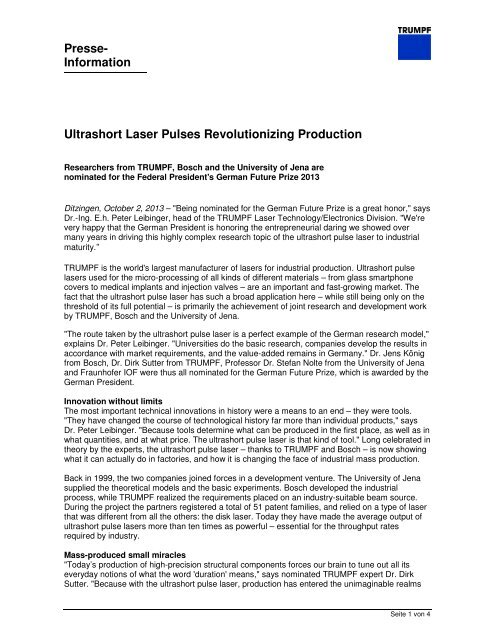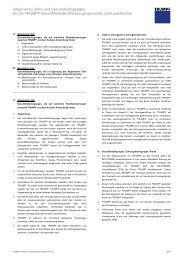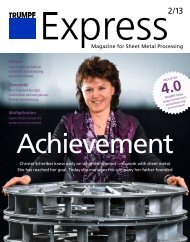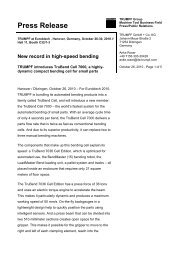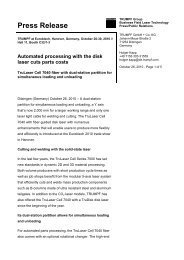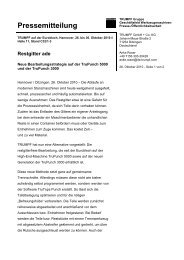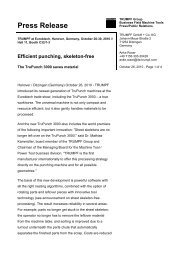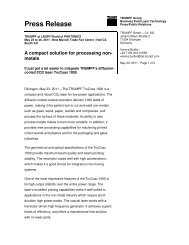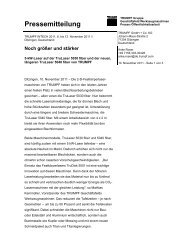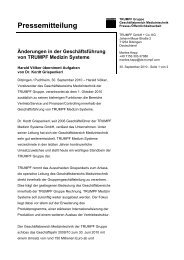Presse- Information Ultrashort Laser Pulses ... - TRUMPF.com
Presse- Information Ultrashort Laser Pulses ... - TRUMPF.com
Presse- Information Ultrashort Laser Pulses ... - TRUMPF.com
Create successful ePaper yourself
Turn your PDF publications into a flip-book with our unique Google optimized e-Paper software.
<strong>Presse</strong>-<br />
<strong>Information</strong><br />
<strong>Ultrashort</strong> <strong>Laser</strong> <strong>Pulses</strong> Revolutionizing Production<br />
Researchers from <strong>TRUMPF</strong>, Bosch and the University of Jena are<br />
nominated for the Federal President's German Future Prize 2013<br />
Ditzingen, October 2, 2013 – "Being nominated for the German Future Prize is a great honor," says<br />
Dr.-Ing. E.h. Peter Leibinger, head of the <strong>TRUMPF</strong> <strong>Laser</strong> Technology/Electronics Division. "We're<br />
very happy that the German President is honoring the entrepreneurial daring we showed over<br />
many years in driving this highly <strong>com</strong>plex research topic of the ultrashort pulse laser to industrial<br />
maturity."<br />
<strong>TRUMPF</strong> is the world's largest manufacturer of lasers for industrial production. <strong>Ultrashort</strong> pulse<br />
lasers used for the micro-processing of all kinds of different materials – from glass smartphone<br />
covers to medical implants and injection valves – are an important and fast-growing market. The<br />
fact that the ultrashort pulse laser has such a broad application here – while still being only on the<br />
threshold of its full potential – is primarily the achievement of joint research and development work<br />
by <strong>TRUMPF</strong>, Bosch and the University of Jena.<br />
"The route taken by the ultrashort pulse laser is a perfect example of the German research model,"<br />
explains Dr. Peter Leibinger. "Universities do the basic research, <strong>com</strong>panies develop the results in<br />
accordance with market requirements, and the value-added remains in Germany." Dr. Jens König<br />
from Bosch, Dr. Dirk Sutter from <strong>TRUMPF</strong>, Professor Dr. Stefan Nolte from the University of Jena<br />
and Fraunhofer IOF were thus all nominated for the German Future Prize, which is awarded by the<br />
German President.<br />
Innovation without limits<br />
The most important technical innovations in history were a means to an end – they were tools.<br />
"They have changed the course of technological history far more than individual products," says<br />
Dr. Peter Leibinger. "Because tools determine what can be produced in the first place, as well as in<br />
what quantities, and at what price. The ultrashort pulse laser is that kind of tool." Long celebrated in<br />
theory by the experts, the ultrashort pulse laser – thanks to <strong>TRUMPF</strong> and Bosch – is now showing<br />
what it can actually do in factories, and how it is changing the face of industrial mass production.<br />
Back in 1999, the two <strong>com</strong>panies joined forces in a development venture. The University of Jena<br />
supplied the theoretical models and the basic experiments. Bosch developed the industrial<br />
process, while <strong>TRUMPF</strong> realized the requirements placed on an industry-suitable beam source.<br />
During the project the partners registered a total of 51 patent families, and relied on a type of laser<br />
that was different from all the others: the disk laser. Today they have made the average output of<br />
ultrashort pulse lasers more than ten times as powerful – essential for the throughput rates<br />
required by industry.<br />
Mass-produced small miracles<br />
"Today’s production of high-precision structural <strong>com</strong>ponents forces our brain to tune out all its<br />
everyday notions of what the word 'duration' means," says nominated <strong>TRUMPF</strong> expert Dr. Dirk<br />
Sutter. "Because with the ultrashort pulse laser, production has entered the unimaginable realms<br />
Seite 1 von 4
<strong>Presse</strong>-<br />
<strong>Information</strong><br />
of the temporally tiny. '<strong>Ultrashort</strong>' here means a pulse lasting only picoseconds (10 - ¹² seconds)."<br />
While a ray of light needs around one second to get from the Earth to the Moon, within one<br />
picosecond it only travels a distance of 0.3 millimeters. Concentration of laser radiation into such<br />
brief time periods leads to enormous peaks in performance.<br />
Hundreds of thousands of these tiny laser flashes are generated every second, and this sequence<br />
of pulses has a further effect. When material is under fire at picosecond intervals it has no time to<br />
melt, instead it actually sublimates. Skillful selection of pulse duration, pulse energy, cycle rate and<br />
the right focus heats up the material so quickly and powerfully that it breaks off and vaporizes<br />
without melting – and can then be simply sucked away using a stream of air. This enables ablation<br />
in the very finest ranges of just a few millionths of a millimeter (i.e. nanometers) – without any burr<br />
formation from residual melt, or any heat transfer to the material that would impair its quality. In<br />
production, this is referred to as “cold processing”; the process transfers no heat, and leaves no<br />
residue behind.<br />
Contribution toward gasoline saving<br />
Until only a few years ago, this small miracle only occurred in research chambers at universities,<br />
under laboratory conditions. Today Bosch is mass-producing structural <strong>com</strong>ponents in their<br />
millions with the ultrashort pulse laser for sectors such as the automotive industry. One example is<br />
a direct injection valve for gasoline: Here, the ultrashort pulse laser drills geometrically <strong>com</strong>plex<br />
injection holes with smooth walls. This distributes the gasoline more efficiently in the <strong>com</strong>bustion<br />
chamber, contributing toward fuel savings of up to 20 percent. Thanks to the new production<br />
process this optimization can also be achieved in engines with medium, smalls and ultra-small<br />
displacements. The advantages of direct injection – less consumption and fewer emissions – are<br />
therefore available for all vehicle classes now.<br />
<strong>Ultrashort</strong> pulse lasers are also suitable for the high-precision machining of almost all materials,<br />
including ceramics, sapphire, carbon fiber, plastics or glass. A second example from practice:<br />
cover screens on smartphones, which have to be extremely thin and very hard at the same time. If<br />
they are cut out using diamond saws or other methods, microscopic cracks often appear in the<br />
glass. With the ultrashort pulse laser this danger can be avoided – which is why it has developed<br />
into the tool of choice for the world's largest manufacturers.<br />
There are also the minimal invasive processes used in medical technology – in the production of<br />
stents, for example, which are used to keep blood vessels open. To prevent them from damaging<br />
the vessels and to stop any blood clots from forming, stents have to be absolutely burr-free. Today,<br />
they are made from nitinol, for instance, a shape-memory alloy. With the fusion cutting method<br />
used so far, stents had to be deburred. Now, with the ultrashort pulse laser, stents can be<br />
produced without the need for refinishing work – and this also makes them far cheaper. Clinical<br />
studies are currently being carried out on bioresorbable coronary stents made from polymer, which<br />
dissolves in the body after a certain time period. The production of stents like these is only possible<br />
with ultrashort pulse lasers.<br />
><br />
A finger on the pulse of the times<br />
These three examples alone demonstrate how industry is making use of the ultrashort pulse laser.<br />
<strong>TRUMPF</strong> has standardized the laser sources and is now supplying them to industry. The<br />
manufacturers certainly have their finger on the ultrashort pulse of the times: Sectors such as the<br />
automotive industry, semiconductor production, industrial technology, medical technology, the<br />
Seite 2 von 4
<strong>Presse</strong>-<br />
<strong>Information</strong><br />
photovoltaic sector and the electronics industry are all developing applications for ultrashort pulse<br />
lasers. By the end of 2013, Bosch will have delivered 30 million <strong>com</strong>ponents fabricated using<br />
ultrashort pulse technology to its customers worldwide. By the year 2020 the number of<br />
picosecond lasers in use at Bosch is expected to have more than tripled.<br />
<strong>TRUMPF</strong> is the world leader with regard to the average power, modulation capability and pulse<br />
stability of this laser. "Apart from the disk laser technology, what is unique here above all is the<br />
safe and precise control technology. The patented double control loop monitors every single<br />
picosecond pulse and keeps the power and the pulse energy at exactly the level required,<br />
independent of external influences", explains Dr. Dirk Sutter. This is done by means of an external<br />
modulator which decouples the pulse build-up from the power control, so it always delivers<br />
precisely the power and pulse energy needed – while beam quality and pulse duration remain<br />
constant.<br />
With this development <strong>TRUMPF</strong> offers an extremely robust laser concept, specially designed to<br />
make it ideal for operation in today's three-shift production. No need to sacrifice quality for<br />
economic efficiency here: With average outputs of over 150 watts, the <strong>TRUMPF</strong> picosecond lasers<br />
are among the fastest and most powerful in the world.<br />
Right of usage:<br />
Attached to this press release are digital photos at resolution suitable for printing. They<br />
may only be used for editorial purposes. Use is free of charge when credit is given as<br />
“Photo: <strong>TRUMPF</strong> Group” and a <strong>com</strong>plimentary copy is sent to the above address.<br />
Graphic editing – except for the purpose of extracting the main motive – are prohibited.<br />
Additional photos can be accessed on the <strong>com</strong>pany website:<br />
www.trumpf.<strong>com</strong>/presse/medienservice<br />
Dr.-Ing. E.h. Peter Leibinger<br />
"Being nominated for the German Future<br />
Prize is a great honor", says Dr.-Ing.<br />
E.h. Peter Leibinger, head of <strong>TRUMPF</strong>'s<br />
<strong>Laser</strong> Technology/Electronics Division.<br />
The nominated team<br />
Dr. Dirk Sutter, <strong>TRUMPF</strong> (left), Dr. Jens<br />
König, Bosch (middle), and Professor<br />
Stefan Nolte, University of Jena and<br />
Fraunhofer IOF have been nominated<br />
for the German Future Prize, awarded<br />
by the German President.<br />
Seite 3 von 4
<strong>Presse</strong>-<br />
<strong>Information</strong><br />
Glass cutting<br />
Cover screens on smartphones are<br />
extremely hard and thin. Cutting them<br />
with ultrashort pulse lasers successfully<br />
prevents microscopic cracks on the<br />
edges – leading to longer service life.<br />
Stent production<br />
To prevent injury to blood vessels,<br />
stents have to be absolutely burr-free.<br />
Today's stents are made from nitinol,<br />
for instance, a shape-memory alloy.<br />
The ultrashort pulse laser eliminates<br />
the need for refinishing work – making<br />
production far cheaper.<br />
<br />
About <strong>TRUMPF</strong><br />
<strong>TRUMPF</strong> is a leading global technology <strong>com</strong>pany with Machine Tools, <strong>Laser</strong> Technology, Electronics and<br />
Medical Technology as its business fields. Products manufactured with the <strong>com</strong>pany's technology can be<br />
found in almost every sector of industry. <strong>TRUMPF</strong> is the world technological and market leader for machine<br />
tools used in flexible sheet metal processing, and also for industrial lasers.<br />
In 2012/13 the <strong>com</strong>pany – which has approximately 9,900 employees – achieved sales of 2.35 billion Euros<br />
(preliminary figures for the 2012/13 fiscal year). With around 60 subsidiaries and branches, the <strong>TRUMPF</strong><br />
Group is represented in almost all the countries of Europe, North and South America, and Asia. It has<br />
production facilities in Germany, China, France, Great Britain, Japan, Mexico, Austria, Poland, Switzerland,<br />
Singapore, the Czech Republic and the USA.<br />
For more information about <strong>TRUMPF</strong> go to www.trumpf.<strong>com</strong><br />
For interview questions for Dr. Peter Leibinger or Dr. Dirk Sutter<br />
and other press questions please contact:<br />
Verena Buttler<br />
Anke Roser<br />
Press Officer, <strong>Laser</strong> Technology<br />
Deputy Press Officer<br />
+49 7156 303-31559 +49 7156 303-30992<br />
Verena.Buttler@de.trumpf.<strong>com</strong><br />
Anke.Roser@de.trumpf.<strong>com</strong><br />
<strong>TRUMPF</strong> GmbH + Co. KG<br />
Johann-Maus-Strasse 2<br />
71254 Ditzingen<br />
Germany<br />
Seite 4 von 4
<strong>Presse</strong>-<br />
<strong>Information</strong><br />
More information about ultrashort pulse lasers and the institutions<br />
nominated for the German Future Prize can be found here:<br />
www.trumpf-laser.<strong>com</strong><br />
www.laser-<strong>com</strong>munity.de<br />
www.bosch.<strong>com</strong><br />
www.uni-jena.de<br />
Seite 5 von 5


